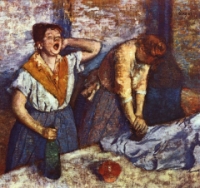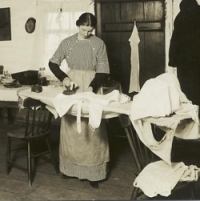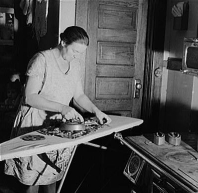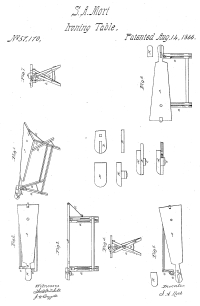Ironing tables, ironing boards, ironing blankets
 It may seem obvious that ironing has to be done on a flat surface, but there have been exceptions. Chinese pan irons were sometimes used on cloth stretched in mid air between two people. Ancestors of the ironing board include, in the West, the whalebone smoothing boards buried with Viking ladies, and in the East, the stone slabs used with Korean ironing sticks. (See'history of ironing' page.) The smoothing boards, about 33 cm or 1 foot long, are thought to have been used with the glass linen smoothers also found at Viking burial sites. Boards small enough to hold on the lap were still in use in the 19th century. Known as press boards, these were often used for ironing seams while dressmaking, but could also be used when pressing laundry.
It may seem obvious that ironing has to be done on a flat surface, but there have been exceptions. Chinese pan irons were sometimes used on cloth stretched in mid air between two people. Ancestors of the ironing board include, in the West, the whalebone smoothing boards buried with Viking ladies, and in the East, the stone slabs used with Korean ironing sticks. (See'history of ironing' page.) The smoothing boards, about 33 cm or 1 foot long, are thought to have been used with the glass linen smoothers also found at Viking burial sites. Boards small enough to hold on the lap were still in use in the 19th century. Known as press boards, these were often used for ironing seams while dressmaking, but could also be used when pressing laundry. A kitchen table or a board supported by two chairs were both in common use for ironing before the days of the mass-market folding ironing board. (See picture left of a woman using a flatiron on a board balanced over chairs.) There was plenty of advice in 19th century housekeeping books about what size an ironing table should be (various opinions), what wood it should be made of (pale softwood for cleanliness, oak for strength), and how it should be covered (thick woollen ironing-blanket in white baize or red flannel, with a sheet or ironing-cloth on top).
A kitchen table or a board supported by two chairs were both in common use for ironing before the days of the mass-market folding ironing board. (See picture left of a woman using a flatiron on a board balanced over chairs.) There was plenty of advice in 19th century housekeeping books about what size an ironing table should be (various opinions), what wood it should be made of (pale softwood for cleanliness, oak for strength), and how it should be covered (thick woollen ironing-blanket in white baize or red flannel, with a sheet or ironing-cloth on top). Swanskin was often recommended as an ironing blanket in England. Nothing to do with large feathered wings, but a dense scarlet fabric used to cover ironing tables. Using your red woollen cloak for this purpose was frowned upon by 19th century English women writers, but it must have been quite common or it wouldn't have been mentioned so regularly. (See quotes below) In George Washington's household at Mount Vernon in Virginia the ironing blankets were made of thick woollen "fearnought".
Swanskin was often recommended as an ironing blanket in England. Nothing to do with large feathered wings, but a dense scarlet fabric used to cover ironing tables. Using your red woollen cloak for this purpose was frowned upon by 19th century English women writers, but it must have been quite common or it wouldn't have been mentioned so regularly. (See quotes below) In George Washington's household at Mount Vernon in Virginia the ironing blankets were made of thick woollen "fearnought". Folding ironing boards arrived as the Victorians channelled their inventiveness into finding better ways of managing a household. The first US patents for these appeared in the 1860s. Some shapes that we would now call ironing boards were called ironing tables. Inventors designed ironing bureaus, and even ironing tables combined with quilting frames. Different boards were made for specialised tasks like ironing sleeves, and there were ironing board accessories for special jobs like ironing bonnets. While the woman (above right) in North Dakota in 1940 has a folding board, she is not using an electric iron, but a sadiron with detachable handle, probably the famous Mrs. Potts' patented iron. Note the two spare iron bases heating on the stove.
Folding ironing boards arrived as the Victorians channelled their inventiveness into finding better ways of managing a household. The first US patents for these appeared in the 1860s. Some shapes that we would now call ironing boards were called ironing tables. Inventors designed ironing bureaus, and even ironing tables combined with quilting frames. Different boards were made for specialised tasks like ironing sleeves, and there were ironing board accessories for special jobs like ironing bonnets. While the woman (above right) in North Dakota in 1940 has a folding board, she is not using an electric iron, but a sadiron with detachable handle, probably the famous Mrs. Potts' patented iron. Note the two spare iron bases heating on the stove.
This US patent from 1866 (left) described "A new and Improved Ironing-Board adapted principally for the use of ladies’ dress and other skirts, shirt-fronts, or any piece of clothing that requires to be ironed single, and, with the bonnet-block attached to the neck of the ironing board, bonnets and other pieces of clothing may be ironed with great advantage . . The nature of my invention consists in an improvement in the ordinary ironing board, over which it possesses many advantages. It is lighter and durable, and when extended it can be placed anywhere, and when not in use can be folded to the capacity of an ordinary board, which renders it very convenient."
Best Ironing Boards
ReplyDelete